Norman Franke – 22 February, 2024
Traces was a collection of inspired works that attested to fascinating interpretations of the two lemmata of the word ‘trace': ‘a mark, object, or other indication of the existence or passing of something' and ‘a very small quantity, especially one too small to be accurately measured'. In the exhibition, the ‘very small' opened vistas of the unexpected, often substantial and profound, and the ‘mark of the existence or passing of something' provided a far wider context.
Hamilton
Arwen Flowers, Peter Hsu, Teresa Martinovich, Sybille Schlumbom
Traces
27 January to 10 February 2024.
The exhibition Traces by four Auckland University of Technology (AUT) students, Arwen Flowers, Peter Hsu, Teresa Martinovich, and Sybille Schlumbom, opened the Waikato galleries’ exhibition season with a roaring success, as the group exhibition demonstrated the wealth of ideas and the technical skills of all artists involved. All four contributors are studying for a master’s degree at AUT and all four demonstrated their abilities to artistically engage with a challenging theme: ‘traces’—the common denominator being the ‘examining of site-specific gestural and material interactions occurring within various timeframes’. (1.)
The artists’ individual works or small groupings of works were elegantly presented and accompanied by artists’ statements about their respective practices. The close coordination and teamwork of the group was evident in the organisation, with the Waikato Society of Arts’ Blue Gallery being a difficult exhibition space to accommodate, due to the industrial blue carpeting, unusual room proportions, and erratic lighting from the street windows and neon lights from the ceiling.
These major challenges for hanging and presenting the objects were overcome by using Hsu’s powerful large ink drawing on silk cloud somersault which was suspended from one wall and the ceiling as both a partitioning and a transitioning device. Cloud somersault created a translucent sculpture in the centre of the room and allowed for a more intimate and sheltered space for the several works on paper and canvas mounted on the back walls.
According to her own artist statement, Arwen Flowers ‘adopts an exploratory approach‘ in her paintings that ‘questions how housework practice contributes to an embodied relationship with surfaces‘. (2.) We all are familiar with the ‘smears, puddles and sprinkles’ that are part of food-making, cleaning and rearranging processes in the domestic sphere. In her large paintings, Flowers magnified and dissected the dynamics of these minute spaces.
In Pass the salt, for example, simple household items like salt and pepper that leave mostly overlooked traces on plates and kitchen surfaces became a dramatic interplay of white, black and grey colours that are blurred and chaotic. But in addition to the title suggesting a micro-cosmos of salt crystals, the work was also regarded as cloud formations or intergalactic nebulae of stars. ‘Chaos’ and ‘control’ are both gestural features of micro- and macroscopic spaces and also the artist’s corporeal interaction with the elements of their creation. They can be confusing, awe-inspiring, and also off-putting when colours and forms don’t harmonise and the ‘unsightly’ dimensions of ‘organic smear’ or ‘elbow grease’ become prominent.
In her painting, Flowers’ palette was restrained, based on just two or three different colours and their various hues and shades. She also experimented with mixing colours close to grey in quality. Flowers’ art was an eye-opener for the transitoriness and underlying messiness of clearly distinct and often sanitised spaces at home but also at work—and in galleries. As an extended sanitary project, ‘civilisation’ itself appeared to be an ultimately futile fight against jumble, disorder and instability.
Peter Hsu’s large ink drawings on silk and canvas also dealt with forms of contingency and intention, transience and permanence, and traces of human and natural creation in space and time. Following traditions of ancient Chinese calligraphy and combining painting and writing, Hsu works primarily with black characters on a white background, hinting at aspects of the tension as well as complementarity of opposites, of Yin and Yang. Hsu’s previously mentioned, several-meter-long painted silk ribbon cloud somersault, looked like a delicate textile sculpture onto which human and cosmic signs and symbols were inscribed. When the gallery door opened and a breeze from the outside entered the room, one could discern a subtle movement of the fabric in the room, fine ripples on the woven layer and superimposed human-facilitated signs.
Although the individual characters were creatively generated, or spontaneously invented, and therefore not part of existing dictionaries, they awakened in many visitors the desire to decipher and understand their meaning. When looking at the silk scroll for long periods of time, relationships and sequences emerged, but they pointed less to semiotically relevant units such as words or concepts, and more to the fact that their meaning was revealed through the process of their creation in space and time, as well as the activity of the creating artist. In Hsu’s own words, his installations ‘are underpinned by Taoist philosophy and a striving to understand creativity, spontaneity, and identity.’ (3.)
Teresa Martinovich’s oil paint and stick on unstretched canvas let these pearl bodies swap and weep was one of the more evocative pieces of the exhibition. Starkly contrasting with the blue and black brutalism of the industrial carpeting of the gallery, her pink and occasionally yellow painting conjured up images of a dress, a seashell or a flag, but its energetic, yet (ironically?) girlish pinkness also raised questions of gender, representation and agency. The painting was accompanied by a poem of the artist whose first lines read:
Cloak the dreary line in its woven finery
amber and pink and lavender and cream
hoisted up by golden pickets […] (4.)
Turning visual art into poetry and vice versa, the ancient poetic genre of ekphrasis came into its own here. When asked about the work’s gestation, the artist was no longer sure which came first, the painting or the poem, but this only attested to the intimate dialogue between the two. Like painting, poetry cannot be reduced to a single message or meaning or a formally logic argument. As in her painting (paint and stick [sic!] on unstretched canvas) the poem invoked traces of both beauty and danger (‘bathe in the celestial mercury above‘, ‘let these pearl bodies swap and weep‘), both in nature and in human culture. There was an allusion to traditional notions of artistic inspiration and even metaphysics of creation (‘… soft thread folded into forlorn muse / reaching out towards its forgotten heaven...’) (5.) but as in the poem, the painting’s ‘unfinished’ edges and brush-strokes opened up an ambivalence or dilemma: the ends of the depicted pink entity in the painting’s centre could have been the wings of an infant angel, but it is not clear if these potential pinions were growing or if they were clipped.
In her equally auratic and enigmatic prints, Sybille Schlumbom approached the exhibition’s theme of ‘traces’ in an idiosyncratic way. Inspired by the Japanese Mokuhanga tradition, which she has been intensively involved with for many years, Schlumbom kept a congenial eye on the properties of her materials and their intrinsic messages—to perceive the artistic potential and transcendence of the materials. She had invented her own original printing process in which the places and times of the work’s creation coordinate with her vision and activities.
For example, when Schlumbom submerged some sizeable metal scrolls in the Waikato River, she set in motion a process of change and erosion on the metal’s surface. These rust coloured surfaces were then printed on special Japanese printing paper and partly overwritten again with further decorative forms such as concentric circles and characters. They were then finally framed with precious textile cuttings and suspended from high to the floor. The result was a stunning mixture of print and sculpture, of human and natural creativity, and of multi-cultural significance.
The upper part of the work of Light and Water was attached to an outside window of the gallery, so that the minimally coloured printing paper became transparent when exposed to sunlight and was vaguely reminiscent of a stained-glass church window. The lower part of the work, closer to earth, suggested a geological map or a soil profile, perhaps of a Martian or desert landscape, which revealed how intensely the colours were connected to their elemental substrate. Between the upper and lower parts of the print sculpture, creative tensions and dialogical stories arose that spoke of esotericism and tellurism, of developments in space and time. The overall wave form of the scroll—and the fact that the images were generated in the Waikato Awa—also connected the work with the element of water.
In Light and Water, the German-born artist connected important places of her personal and artistic development. In her art one seemed to hear echoes of the German-speaking philosopher Ernst Bloch, who spoke of the ‘co-productivity of a natural subject’ (6.) in science and art. In addition, there were hints of Japanese Zen traditions which emphasised the simplicity and grandiosity of hospitable places, their transience and also their capacity for the engagement and encountering of different communities. And finally, there was a nod to the deeply rooted sense of place and belonging that the Waikato River provided for the Tainui Iwi and their friends.
To sum up, Traces was a collection of inspired works that attested to fascinating interpretations of the two lemmata of the word ‘trace’: ‘a mark, object, or other indication of the existence or passing of something‘ and ‘a very small quantity, especially one too small to be accurately measured‘. In the exhibition, the ‘very small‘ opened vistas of the unexpected, often substantial and profound, and the ‘mark of the existence or passing of something‘ provided a far wider context, including allusions to the Tao, Space-Time and the Second Thermodynamic Law.
Norman Franke
(1.) https://wsa.org.nz/
(2.) Artist’s statement, Arwen Flowers, Trace exhibition, February 2024
(3.) Artist’s statement, Peter Hsu, Trace exhibition, February 2024
(4.) Artist’s statement, Teresa Martinovich, Trace exhibition, February 2024
(5.) ibid.
(6.) ‘Naturallianz; Mitproduktivität eines hypothetischen Natursubjekts’. Ernst Bloch, Das Prinzip Hoffnung, Frankfurt/M 1977, pp. 802-817
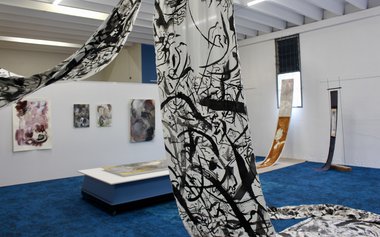







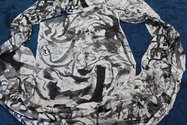
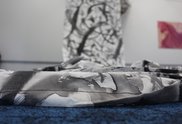
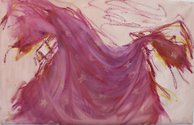
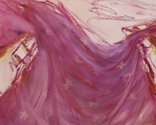





 Two Rooms presents a program of residencies and projects
Two Rooms presents a program of residencies and projects Advertising in this column
Advertising in this column


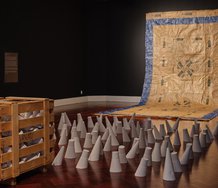
This Discussion has 0 comments.
Comment
Participate
Register to Participate.
Sign in
Sign in to an existing account.